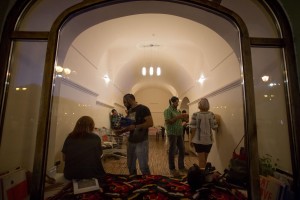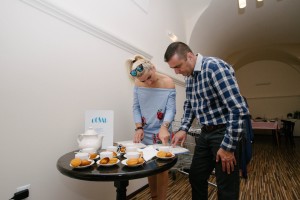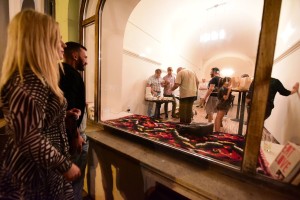Comfort food is food which provides a nostalgic or sentimental value to the consumer, and is often characterised by its high caloric nature, high carbohydrate level, and simple preparation. The nostalgia may be specific to either the individual or a specific culture.
The Comfort Food Continuum is a artistic-social-poetic practice inquiry into the limits of personal identity and food as cultural substance. The project will first and foremost investigate and catalogue online and offline interviews, the connection between dishes, recipes, the materiality of foods and the personal affective memory. The collected materials will be developed as performance pieces where food immersive experiences and the people are introduced to the audience trough a dinner setting performances and installations. The project on the whole is conceived as a durational piece running from 2016 to 2021 and culminating with a performing and analog database of comfort foods performances and installation informed and inspired by food memories from around the world : www.peformingfood.com/comfortfoodcontinuum.
Food and performance converge conceptually at three junctures. First, to perform is to do, to execute, to carry out to completion, to discharge a duty.In other words, all that governs the production, presentation, and disposal of food and their staging. To perform in this sense is to make food, to serve food. It is about materials, tools, techniques, procedures, actions. It is about getting something done. It is in this sense, first and foremost, that we can speak of the performing kitchen.
Second, to perform is to behave. This is what Erving Goffman calls the performance of self in everyday life. Whether a matter of habit, custom, or law, the divine etiquette of ritual, codifications of social graces,the laws governing cabarets and liquor licenses, or health and sanitation codes, performance encompasses the social practices that are part and parcel of what Pierre Bourdieu calls“-habitus. To perform in this sense is to behave appropriately in relation to food at any point in its production,consumption or disposal, each of which may be subject to precise protocols or taboos. Jewish and Hindu laws of ritual purity and formal etiquette stipulate the requirements in exquisite detail. They involve the performance of precepts, as well as precepts of performance.
Third, to perform is to show. When doing and behaving are displayed, when they are shown, when participants are invited to exercise discernment, evaluation, and appreciation, food events move towards the theatrical and, more specifically, towards the spectacular. It is here that taste as a sensory experience and taste as an aesthetic faculty converge.
A century ago Marcel Proust was recalling personal experiences in search of a lost time. At the end of his novel series the author wan concluding that sense memories can have a profound emotional effect, can have an impact on current moods,and for him they clarified why and how he became a creative author. In the 20th century, food and memory are widely used topics for artistic practice, not just for writing but also for performers : the Futurist Manifesto under the form of a Cook Book, Fluxus artists writing their pieces as recipes or individual artists like Gordon Matta Clark, Martha Rosler, Paul McCarthy, Bonnie Ora Sherk, Janine Antoni, Rirkrit Tiravanija, Marje Vogelzang etc. In a similar way, Romaninan artists of the past 50 years have been occupying their practices with food, performance and sensorial experiences: Matei Bejenaru – Alexandru cel Bun, Ștefan Rusu – Converting economies, Vlad Nancă – Holy Grill, Dan Mihălțianu – O-mie-nouă-sute-cincizeci-și-patru, Grupul Subreal – Dracula Land 2, etc.
The Comfort Food Cooking Continuum project in Baia Mare will mark the official debut of a 5-year program reuniting different artists from Europe and around the world around the concepts of food, memory and the construction of individual and collective identities. On this occasion the Schreiber House will host five performances and installations :
Views of the body – chalk and carbon on wall
This performative drawing practice is based on the Taoism notion of the unity of matter and spirit, body and soul. Taoism refuses this dualism and considers the body’s perfection as essential in the same way Christianity views the redemption of the soul..Through drawing performance food memories are a way of understanding how the body, mind and spirit work together.
The Borsch kitchen – performance piece
This performative practice frames the repetition of one comfort food memory ; a child buying the central ingredient of borsch soup and eating the soup.as related to the figure of the grandmother and living in a block of flats in Bucharest under Communist Romania of the 1960s.The performance brings together both text and food reconstruction taking the audience in an intimate
Eating stations – installations
The installations are a further extension of the notion of food as a performance medium in the context of comfort food. Here foodstuffs and personal memory are a material to work with. Like wood, metals and plastics, food and memories are something we can take into and experiment with. The end result is not always something that can be eaten. Examples range from the jokey – Bread Shoes, which are, quite literally, shoes made of bread,to exploring the structural properties of materials made from rice and potatoes by making objects out of them. The installations are based in the conversation practices carried out mostly in Baia Mare and resulting in rapid prototyping that could be used to make new edible forms.
Practicing conversation in an age of distraction and oblivion – performance
This live performance of conversations about food and personal reminiscence is a resource practice for the Comfort Food Continuum, acting as a catalyst to enrich seemingly ordinary conversations, to increasing our capacity to listen deeply and become more self-aware and attentive to others and the values of their lived experiences. In participating in these conversations, we are looking to develop our capacity for greater presence in our daily lives and relationships, leading to inspirational stories of food and memory and increasing our awareness of the deep, natural holiness waiting to be unlocked in our everyday encounters.



